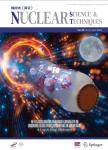Cable coupling response in metal cavity under X-ray irradiation
作者机构:Tsinghua Univ Dept Engn Phys Beijing 100084 Peoples R China Minist Educ Lab Particle & Radiat Imaging Beijing 100084 Peoples R China Zhejiang Univ Coll Elect Engn Hangzhou 310007 Peoples R China
出 版 物:《NUCLEAR SCIENCE AND TECHNIQUES》 (核技术(英文))
年 卷 期:2024年第35卷第10期
页 面:1-11页
核心收录:
学科分类:07[理学] 0827[工学-核科学与技术] 070202[理学-粒子物理与原子核物理] 0702[理学-物理学]
主 题:Ionizing radiation Metal cavity System-generated electromagnetic pulse Transmission-line model SIMULATION CODE EQUATIONS IEMP
摘 要:This study investigates the coupling response of cables inside a metal cavity under X-ray irradiation using the finite-difference time-domain method, particle simulation method, and transmission-line equation to solve the electromagnetic field inside the cavity and load voltage at the cable terminal under X-ray excitation. The results show that under a strong ionizing radiation environment of 1J/cm2\documentclass[12pt]{minimal} \usepackage{amsmath} \usepackage{wasysym} \usepackage{amsfonts} \usepackage{amssymb} \usepackage{amsbsy} \usepackage{mathrsfs} \usepackage{upgreek} \setlength{\oddsidemargin}{-69pt} \begin{document}$${1}\,{\hbox {J/cm}{2}}$$\end{document}, a strong electromagnetic environment is generated inside the cavity. The cable shielding layer terminal couples a voltage of 15.32 V, whereas the core wire terminal couples a voltage of 0.31 V. Under strong X-ray irradiation, the metal cavity not only fails to provide electromagnetic shielding, but also introduces new electromagnetic interference. This study also provides a method for reducing the number of emitted electrons by adding low-Z materials, which can effectively reduce the coupled electric field and voltage.



